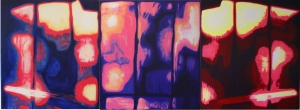It’s been a long time since I’ve written anything for this blog and the reason is that Life has gotten in the way of Art. It seems to me the most sensible thing to do when this happens is to bow to life and do its bidding. I have long admired the writing of Clement Greenberg and one of his quotes which always impressed me is “Life before art.” I know there are famous stories of artists of one sort or another who ignore their loved ones in a mania to work, but that was never something I felt I could do. Art is a close second, but first things first.
Early last year my mother died. I had been her principle caregiver for the previous seven years. It was rough going which included lots of responsibility, worry, tension, anger, work and tremendous amounts of time that was unavoidably idle. Through it all I managed to keep painting and enjoying time with my family, but I had to keep my focus on care giving. Work and “career” were a third concern behind family. However, that was not clear from the start and it took me many years to sort out (accept) my priorities. I never felt very satisfied about anything, because everything seemed shortchanged. Eventually, I made some sort of peace with my situation.
As a compensation for not pursuing my career full time I had the opportunity to do lots of reading on art history and lots of thinking. I came to understand the contemporary art scene about as best as I am able to and I was also able to take a very critical look at what I was doing. During my years as caregiver everything about my work changed. I moved through subject matter and, to a lesser extent, styles, very rapidly. Too rapidly, I think, but I was restless. It seems now that everything I learned and did up to my role as caregiver was acquiring skills and that now I was becoming an artist. I still like the work I did back then, it has great personal value, but I do not see it as vital art in a contemporary sense. My work in the past seven years has, at least, engaged with modern culture whereas previously it seems to have been done with my head down buried in the details (sand).
At some point in my sojourn as caregiver someone said to me that when my mother died I would “have my life back.” While verbally agreeing with that kind thought, I knew that I had no life to go back to. The comment actually caused me to have a real sense of dread because having been taking care of my mother for so long I lost my former sense of self. I didn’t know who I was. There is no going back, whatever I had been doing is lost in time. So I move on and am grateful to able to devote much more time to painting – as to the so-called career, we shall see.
